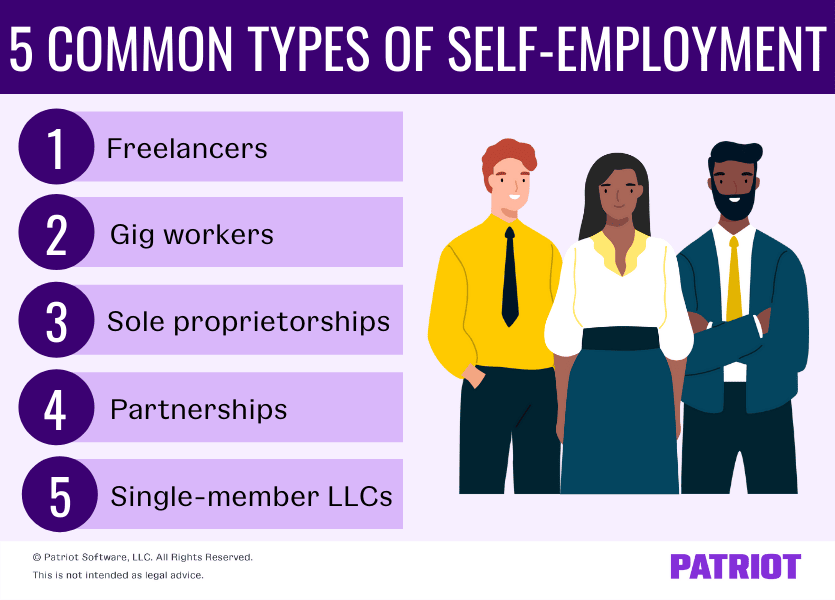Owning a business may mean that you are self-employed. But, the IRS has rules about which business owners are self-employed and which are not. Basically, all self-employed individuals are business owners, but not all business owners are self-employed. So, what are the types of self-employment?
5 types of self-employment
Before we dive into the five types of self-employment, understand what self-employment means.
The IRS states that self-employed individuals must do at least one of the following:
- Conduct business or trade as a sole proprietor or an independent contractor
- Be a member of a partnership that conducts a trade or business
- Be otherwise in business for yourself (full or part time)
Included in the IRS definition of self-employed individuals are members (aka owners) of limited liability companies (LLCs). This is because the government taxes LLCs as sole proprietorships for single-member LLCs or as partners in a partnership for multi-member LLCs.
With these criteria in mind, take a look at the five types of self-employment.

1. Freelancers
The most commonly known form of self-employed individuals is the freelancer (aka an independent contractor or contract worker). According to the IRS, an individual is an independent contractor if the contracting company only controls the results of the work performed. Independent contractors control how they work and what they will do.
Freelancers are their own managers. They are responsible for locating and securing their work as well as billing the client. They control how much, when, and how they work.
Independent contractors are not employees of companies (even though they perform work for them). Contractors are their own employers because they work independently and do not receive Form W-2, Wage and Tax Statement.
Most commonly, contractors receive Form 1099-NEC, Nonemployee Compensation. The 1099-NEC form reports all payments made to the contractor for the calendar year. Contractors do not create these forms for themselves. Instead, the company the contractor performed work for prepares and sends Form 1099-NEC to the contractor at the end of the calendar year.
State laws regarding work policies may exist for contractors. For example, New York requires independent contractors to bear responsibility for wages, benefits, and wage supplements for any subcontractors they may use to perform work.
2. Gig workers
When you think of gig workers, you may picture Uber drivers, DoorDash delivery drivers, or personal trainers. How are these individuals different from freelancers? The difference is subtle.
Like freelancers, gig workers are not employees. And, they do not work permanently for the company for which they perform their work. Gig workers also receive Form 1099-NEC at the end of the year to report wages.
Unlike freelancers, gig workers may have less control over when they work due to the nature of what they do. And while freelancers typically work one contracted job at a time, gig workers may work multiple.
Another difference is that gig work can be much more short-term than freelance work. Freelancers may spend weeks working on one job while a gig worker may move to the next within a matter of minutes (e.g., Uber drivers).
For example, a gig worker doing ride-sharing services may get more business driving on the weekends. Another example of a gig worker is a photographer. Photographers can control their rates and schedules but may require more flexibility based on the nature of their photography work.
Keep in mind that gig and freelance work may be used interchangeably.
3. Sole proprietorships
Many new businesses start as sole proprietorships. An individual who owns and operates their business is a sole proprietor if the government recognizes the business and the individual as the same legal entity. So, business owners receive all of the revenue but assume all the risk and any debts. And, the lack of legal separation means that the business owner’s personal assets are at risk.
Individuals don’t have to declare themselves as sole proprietors when starting a business alone. Instead, they automatically are sole proprietors unless they choose and file paperwork to form a different legal structure.
Sole proprietors must also file all legal documents using their names (because it’s the legal name of their business). However, you may choose to register a different name for your business using a doing business as (DBA) name. Register the DBA name with your state if you decide to use one. But, file all paperwork for government forms or applications using your actual name, not the DBA.
What forms do sole proprietors file for taxes? Sole proprietors file the following two forms:
- Schedule C, Profit or Loss From Business
- Form 1040, U.S. Individual Income Tax Return
Sole proprietors must pay self-employment taxes. And, if you’re a sole proprietor, you may need to pay estimated taxes each quarter.
4. Partnerships
In contrast to sole proprietorships, partnerships are businesses owned by two or more people. Partners may be called co-owners or members.
There are four types of partnerships:
- General partnership: Two or more people own the company and typically share profits and losses equally unless otherwise specified.
- Limited partnership: Business owners partner with silent investors. The silent investors do not make decisions for the company or handle daily operations. And, investors do not have management functions or the risk of liability. This type of partnership is more structured and can only be created under the state’s limited partnership law.
- Limited liability partnership: Members are not personally liable for the business’s debts or other partner’s actions. This type of partnership means that each member is only responsible for their own actions and may be protected from the actions of other members.
- LLC partnership: This type of partnership is a limited liability company with multiple members rather than one owner. In this type of partnership, the members typically cannot be sued for the business’s debts or actions. But, members can be held liable for the actions of other members.
The IRS considers partners to be self-employed for tax purposes. Partnerships have pass-through taxation where profits and losses pass through the business to the members. This type of taxation is why partners are considered self-employed.
All partners must file:
- Form 1065, US Return of Partnership Income
- Schedule K-1, Partner’s Share of Income, Deductions, Credits, etc.
5. Single-member limited liability companies
An LLC is a business entity that is legally separate from its owner. LLC owners have financial and legal protections similar to corporations. So, they can open bank accounts and credit cards under the business name and process transactions without using their personal information.
Because LLCs are separate legal entities, the owner is not held personally liable for any business debts. In other words, owners do not risk their personal assets if the business acquires debt.
Limited liability companies experience pass-through taxation. So, the income tax liability passes through the business to the business owner. And, owners report profits and losses on their personal tax returns, which makes them self-employed to the IRS.
LLC owners are taxed as sole proprietorships and must report the business’s profits and losses on Schedule C, which they attach to their personal income tax return.
Self-employment pros and cons
Regardless of which type of self-employment you choose for your business, there are some pros and cons to consider.
Pros of self-employment include:
- Making your own hours
- Customizing your work environment to you and your needs
- Choosing the type of work you do
- Deciding how you want to do the work
- Earning all of the rewards
- Total control of the business
Cons of self-employment include:
- Working long hours
- Taking on all potential risks for the business
If you do not hire employees or have a partner, you may experience other cons, such as:
- Not having coworkers or being alone while working
- Doing all of the work yourself
- Making every decision, often without input
The benefits of self-employment can work with the drawbacks, too. If you make a decision that doesn’t work (i.e., taking on risk), you have the control to make changes. According to James Crawford, Co-founder of DealDrop:
For me, the greatest benefit to being self-employed is that between my partner and myself, we reap the benefits for the work we put in. They don’t get passed upwards in a command chain. We can determine when and where we work. If we decide that some aspect of the business could be done better, we can change it, and if it doesn’t work, we can decide to try something else, we don’t have to seek permission from elsewhere.”
Before making a decision on the type of self-employment you want to pursue, review the pros and cons of being self-employed. Then, carefully weigh the types of self-employment to determine which option works best for you and your goals. And remember, you may be able to file paperwork to change the legal setup of your business if your type of self-employment needs to change.
This is not intended as legal advice; for more information, please click here.






